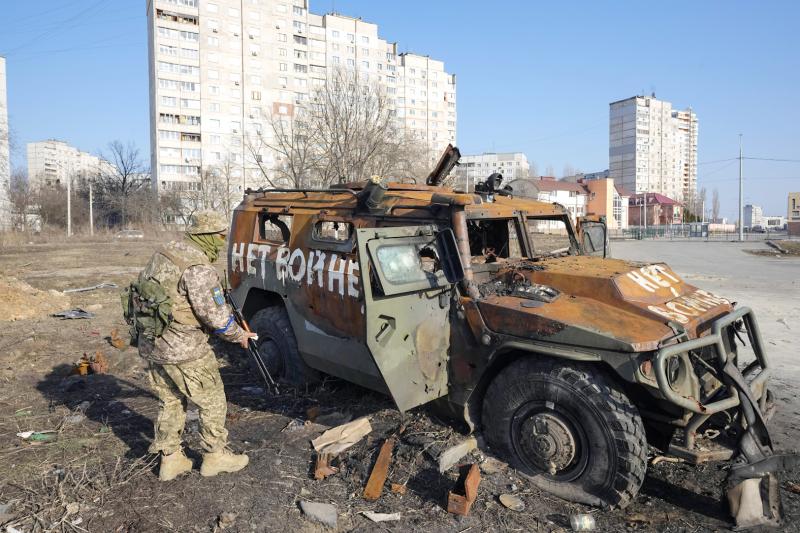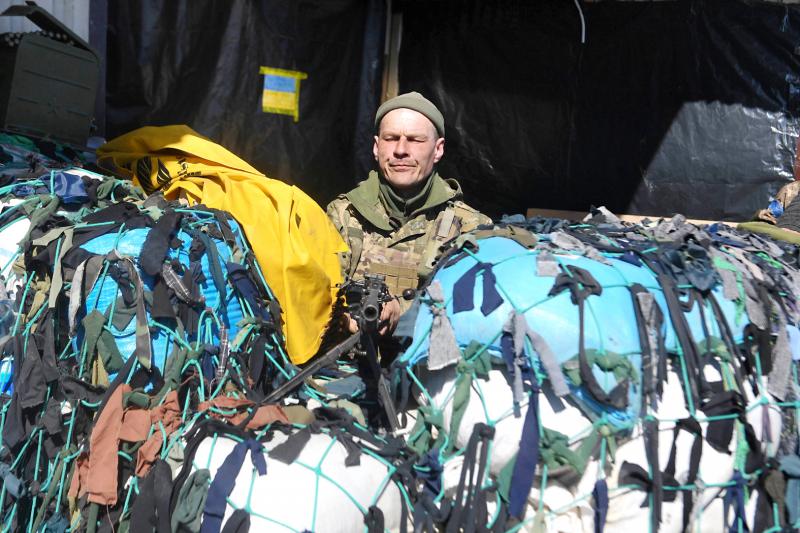Ukraine is employing face recognition technology to identify invading Russian troops killed on its soil, a complex and unprecedented avenue for software already seen as problematic, experts said Thursday.
The embattled nation uses details resulting from the process to try to track down and notify the families of the dead, in an act Ukraine says is aimed at piercing Russia’s war information filter.
While this type of artificial intelligence could offer closure to families denied it by the fog of war or Kremlin secrecy, the potential for mistakes is considerable and consequential.

Photo: AP
“If you’re a Russian parent being informed that your child has been killed when it’s not true, that gets into a complex ethical dilemma,” said Jim Hendler, director of the Institute for Data Exploration and Applications at Rensselaer Polytechnic Institute in New York state.
US-based Clearview AI, often criticized by privacy advocates, says it gave Ukrainian officials free access to its service that matches images from the internet to pictures uploaded by users trying to identify someone.
“The Ukrainian officials who have received access to Clearview AI have expressed their enthusiasm, and we await to hear more from them,” Hoan Ton-That, the firm’s co-founder and CEO, said in a statement.

Photo: EPA-EFE
Ukrainian vice prime minister Mykhailo Fedorov on Wednesday wrote that his nation was using “artificial intelligence” to search social networks for Russian soldiers’ profiles using images of their bodies, to then report their deaths to loved ones.
He added one of the purposes was to “dispel the myth of a ‘special operation,’” referring to Moscow insisting the invasion and war be designated as such.
Ukraine authorities did not reply to requests for further information on Fedorov’s statement.
‘WELL-KNOWN PROBLEMS’
The Kremlin’s last officially released toll was just under 500 soldiers killed, but that has not been updated for weeks and NATO officials reportedly estimated the number of dead, wounded, missing or otherwise out of action Russian troops at up to 40,000.
News of soldiers’ deaths and their funerals have appeared in local Russian media, with reports saying that officials have told families roughly where the deceased fell but few other details.
Facial recognition arrives in the war as technology that has met with significant and sustained doubts, ranging from its intrusion on people’s privacy to criticism it can make errors identifying people of color.
Experts noted that face recognition could be particularly problematic when used on the dead, especially after battlefield wounds leave people looking very different than in a smiling, well-lit picture from a wedding, for example.
“One of the most well-known problems with facial recognition technology is that it’s not perfect, and it will make errors and in some cases those misidentifications can be life changing,” said Eric Goldman, co-director of the High Tech Law Institute at Santa Clara University School of Law.
Yet he noted that long after wars end many families are left not knowing what happened to loved ones who went to battle and were never seen again, and noted the potential utility of technology in those cases.
“We can imagine a circumstance where the ability to reduce the number of people missing in action actually would help,” he added, though he noted face recognition may not be the right solution.
In a letter offering its services to Ukrainian authorities, Clearview — built with images from public Web sites and which it touts as a tool for law enforcement — argued that it indeed would be very useful.
The firm, which Italy fined 20 million euros (almost US$22 million) earlier this month over its software, claimed its database includes some two billion images from VK, Russia’s equivalent to Facebook, and can help identify the dead without needing information like fingerprints.
As for being able to accurately identify the deceased, Clearview claimed to work “effectively regardless of facial damage that may have occurred,” it added, though that claim could not be independently verified.

May 11 to May 18 The original Taichung Railway Station was long thought to have been completely razed. Opening on May 15, 1905, the one-story wooden structure soon outgrew its purpose and was replaced in 1917 by a grandiose, Western-style station. During construction on the third-generation station in 2017, workers discovered the service pit for the original station’s locomotive depot. A year later, a small wooden building on site was determined by historians to be the first stationmaster’s office, built around 1908. With these findings, the Taichung Railway Station Cultural Park now boasts that it has

Wooden houses wedged between concrete, crumbling brick facades with roofs gaping to the sky, and tiled art deco buildings down narrow alleyways: Taichung Central District’s (中區) aging architecture reveals both the allure and reality of the old downtown. From Indigenous settlement to capital under Qing Dynasty rule through to Japanese colonization, Taichung’s Central District holds a long and layered history. The bygone beauty of its streets once earned it the nickname “Little Kyoto.” Since the late eighties, however, the shifting of economic and government centers westward signaled a gradual decline in the area’s evolving fortunes. With the regeneration of the once

The latest Formosa poll released at the end of last month shows confidence in President William Lai (賴清德) plunged 8.1 percent, while satisfaction with the Lai administration fared worse with a drop of 8.5 percent. Those lacking confidence in Lai jumped by 6 percent and dissatisfaction in his administration spiked up 6.7 percent. Confidence in Lai is still strong at 48.6 percent, compared to 43 percent lacking confidence — but this is his worst result overall since he took office. For the first time, dissatisfaction with his administration surpassed satisfaction, 47.3 to 47.1 percent. Though statistically a tie, for most

In February of this year the Taipei Times reported on the visit of Lienchiang County Commissioner Wang Chung-ming (王忠銘) of the Chinese Nationalist Party (KMT) and a delegation to a lantern festival in Fuzhou’s Mawei District in Fujian Province. “Today, Mawei and Matsu jointly marked the lantern festival,” Wang was quoted as saying, adding that both sides “being of one people,” is a cause for joy. Wang was passing around a common claim of officials of the People’s Republic of China (PRC) and the PRC’s allies and supporters in Taiwan — KMT and the Taiwan People’s Party — and elsewhere: Taiwan and